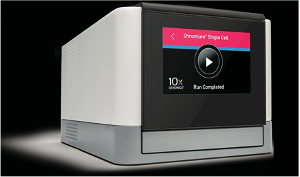Single Cell & Nuclei Preparation for 10x Genomics applications
The Integrated Genomics Lab (IGL) provides support for single cell and nuclei DNA preparation and sequencing using the 10x Genomics Chromium single cell platform. The IGL maintains the Chromium Controller system and provides support for preparation of single cell cDNA and gDNA for 10x Genomics applications. 10x Genomics library preparation and sequencing is performed through the IGL Sequencing Group.
For a Full Service 10x Genomics single cell analysis project from sample submission through sequencing, please go to the IGL Sequencing Group iLab page to request a project. If you prefer to prepare your own single cell DNA and libraries, the IGL Chromium platform is available for Shared Access use once you have received training from a member of the IGL. Training on the Chromium Controller is provided. Trained researchers can schedule use of the Chromium system for their direct use. The IGL Sequencing Group also accepts cDNAs from users and can finish the library preparation for them, and can prepare hashtag and CITE-seq libraries. See below for more information on services and the 10x Genomics workflow in the IGL.

- Hands-on support by IGL staff for all steps following sample collection and cell or nuclei suspension.
- Investigators prepare cells or nuclei in their lab and submit samples to the IGL. IGL staff performs 10X GEM and cDNA prep. Same day process. Followed by library prep and sequencing
- This comprehensive service is requested through the IGL Sequencing Group iLab page.
- For a visual overview of this workflow for full support, please see the image here.
- Access to Chromium workbench in IGL (5th floor Richard Jones Hall)
- 90 minute hands-on training session for Chromium use required; training is provided by IGL staff.
- Trained investigators are granted permission to book the 10X Genomics station in the IGL during normal lab hours (9am - 6pm) or can request extended hour access for processing samples off-hours and on weekends.
10x Chromium Controller Training
Prior to training:
- Training protocol and sample preparation protocol sent to investigator.
- Resources provided for 10X Genomics technology, how-to videos, and sample prep guides.
Day of training:
- Meet with IGL staff at RJH 5330.
- Maximum of two trainees from a single lab.
- Chromium Next GEM Training Kit included.
- Entire training takes ~90 minutes.
- We go through the 10X Genomics training protocol which is an abbreviated version of standard protocol and uses reagents unique to the training kits.
Request training:
- To schedule a training, request the 10x Chromium Controller training on the iLab IGL RNA & DNA Services page.
The 10x Genomics 3’ Gene Expression assay can be supplemented in two ways
The standard 10x Genomics recommendation for the library preparation protocol is that the maximum number of cells per library is 10,000. Generally, most users will assay 10,000 cells from one sample. Occasionally users may have a set of samples that individually have fewer than 10,000 cells each, but that can add up to 10,000 cells (so, for example, sample A has 2000 cells, sample B has 3000 cells, and sample C has 5000 cells). It is possible to combine these samples into one library by tagging the cells in each sample with a unique identifier. This is referred to as a hashtag. Oligonucleotide-antibody conjugates are available for this from external vendors, for example, BioLegend (TotalSeq A and B). Alternatively, a lipid-based oligonucleotide tagging system is available from 10x Genomics. Details on each of these are available from the appropriate vendor. Cells that have hashtags are identified informatically after alignment to the reference genome.
The IGL does not do hashtagging. It is the responsibility of each user to select their tagging method, to treat their cells, and to mix them prior to delivery to the IGL for processing. The IGL is able to complete the libraries for these protocols.
To process the samples appropriately, users need to add the oligonucleotide sequence used for each sample to the sample submission form they deliver to the IGL.
Clients can do some basic proteomics work with their single-cell gene expression studies by using antibody-oligonucleotide conjugates. Unlike work with hashtags which use antibodies to universal cell surface proteins, the antibodies used for CITE-Seq target specific cell-surface proteins of interest. Differential analysis of the oligonucleotides after cluster analysis of the sequence data can provide insight into translation and recycling of the targeted proteins. Multiple CITE-Seq oligo-antibody conjugates can be used in a single experiment and CITE-Seq can be combined with hashtags as needed.
Resources for planning experiments
- IGL members:
- Bob Searles (searlesr@ohsu.edu) – first point of contact
- Alex Klug (klug@ohsu.edu)
- Chris Harrington (harringc@ohsu.edu)
- Amy Carlos (carlosa@ohsu.edu)
- 10X Genomics specialists:
- Wendy Love – Sales Executive (wendy.love@10xgenomics.com)
- Nicole Bowman – Sales Associate (nicole.bowman@10xgenomics.com)